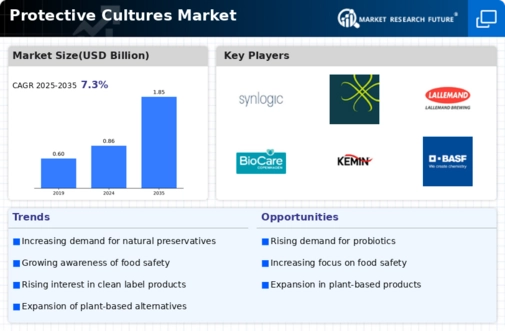Market Growth Projections
The Global Protective Cultures Market Industry is projected to experience substantial growth, with estimates indicating a rise from 0.86 USD Billion in 2024 to 1.85 USD Billion by 2035. This growth trajectory suggests a robust market expansion driven by various factors, including technological advancements, increasing consumer awareness, and the rising demand for natural preservatives. The anticipated CAGR of 7.22% from 2025 to 2035 further underscores the potential for significant market development. These projections highlight the evolving landscape of food preservation and the critical role of protective cultures in meeting consumer needs.
Emerging Markets and Globalization
Emerging markets are becoming increasingly important for the Global Protective Cultures Market Industry as globalization facilitates the exchange of food products and preservation technologies. Countries in Asia-Pacific and Latin America are experiencing rapid urbanization and changing dietary patterns, leading to a higher demand for preserved foods. This trend presents significant opportunities for the adoption of protective cultures in these regions. As global trade continues to expand, the market is likely to benefit from increased accessibility to protective cultures, thereby enhancing food safety and quality across diverse markets.
Growth in the Processed Food Sector
The expansion of the processed food sector is a key driver for the Global Protective Cultures Market Industry. As consumer lifestyles evolve, there is a growing demand for convenient and ready-to-eat food products. Protective cultures play a crucial role in extending the shelf life and maintaining the quality of these products. The processed food industry is projected to continue its growth trajectory, further fueling the demand for protective cultures. This trend is indicative of a broader shift towards convenience in food consumption, which is likely to sustain the growth of the Global Protective Cultures Market Industry in the coming years.
Increasing Awareness of Food Safety
The Global Protective Cultures Market Industry is significantly impacted by the rising awareness of food safety among consumers and regulatory bodies. With foodborne illnesses posing a serious public health risk, there is a heightened focus on ensuring food safety through effective preservation methods. Protective cultures serve as a proactive measure to prevent spoilage and contamination, thus enhancing food safety. This awareness is leading to stricter regulations and standards that encourage the use of protective cultures in food production. Consequently, the market is poised for growth as stakeholders prioritize safety and quality in food products.
Rising Demand for Natural Preservatives
The Global Protective Cultures Market Industry is witnessing an increasing demand for natural preservatives as consumers become more health-conscious. This trend is driven by a shift away from synthetic additives towards more natural alternatives. Protective cultures, which are beneficial microorganisms, offer a natural solution to extend shelf life and enhance food safety. For instance, the market is projected to reach 0.86 USD Billion in 2024, reflecting a growing preference for clean label products. This shift not only caters to consumer preferences but also aligns with regulatory trends favoring natural ingredients, thereby propelling the growth of the Global Protective Cultures Market Industry.
Technological Advancements in Food Preservation
Technological innovations in food preservation techniques are significantly influencing the Global Protective Cultures Market Industry. Advances in fermentation technology and microbial research have led to the development of more effective protective cultures that can inhibit spoilage and pathogenic microorganisms. These innovations enhance the efficacy of protective cultures, making them more appealing to food manufacturers. As a result, the market is expected to grow at a CAGR of 7.22% from 2025 to 2035, reaching an estimated value of 1.85 USD Billion by 2035. This growth underscores the importance of technology in driving the adoption of protective cultures in various food applications.





















